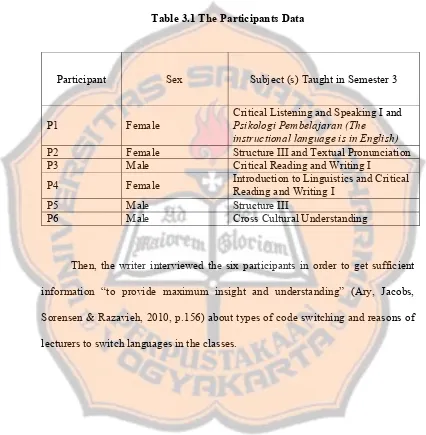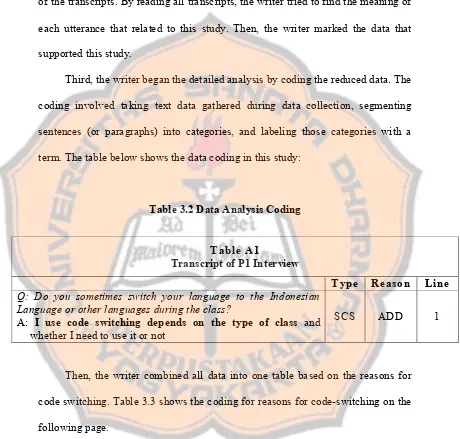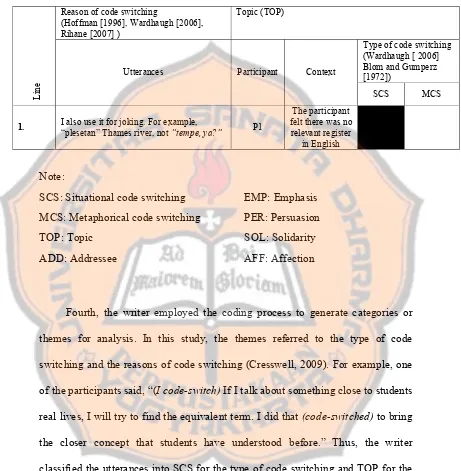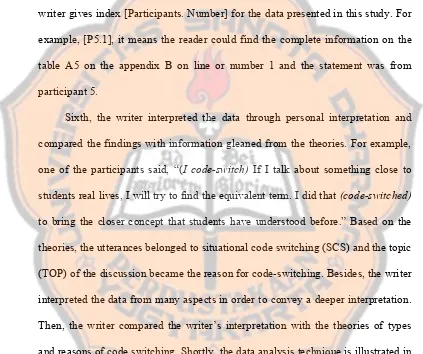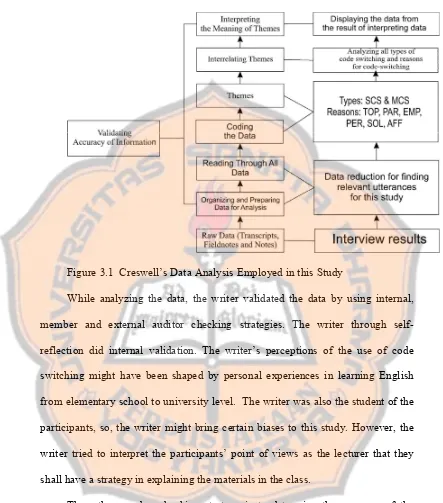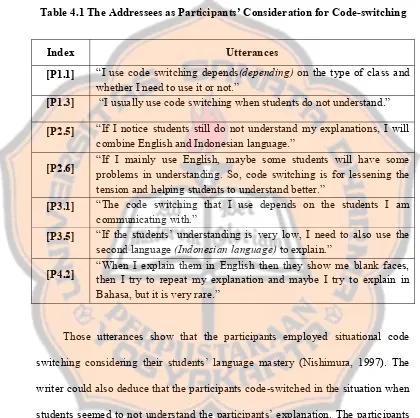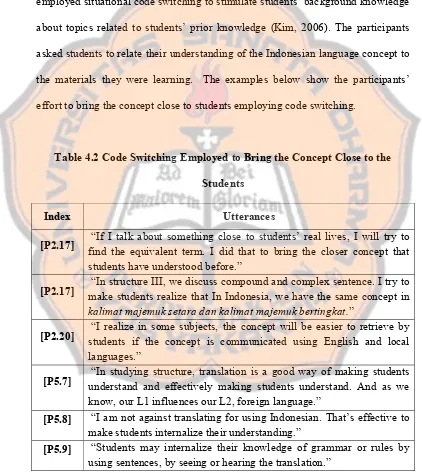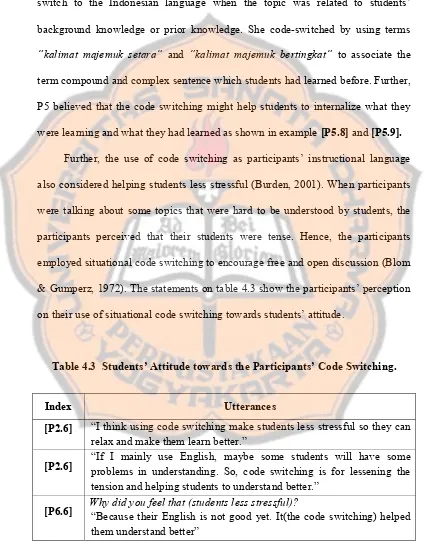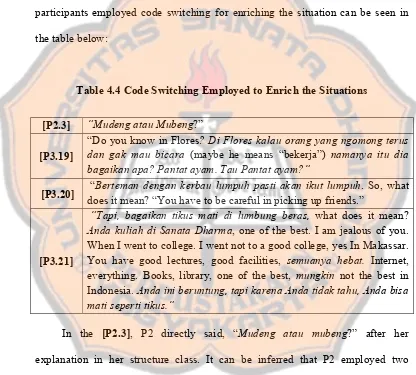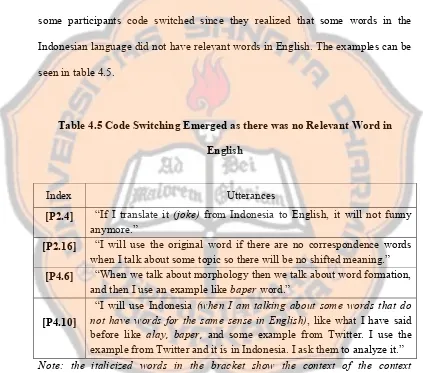ABSTRACT
Mukti, Thomas Wahyu Prabowo. (2016). The Use of Code Switching in the
English Language Education Study Program Lecturers’ Instructional Languages.
Yogyakarta: English Language Education Study Program, Sanata Dharma
University.
The fact that many languages exist in this world makes people tend to learn
new languages. The phenomenon of learning new languages leads to another
phenomenon; code switching. Further, language is an essential mean of
communication in teaching and learning activities. In the English Language
Education Study Program (ELESP), English is the main instructional language for
teaching and learning activities. Considering that English was not students’ first
language, some lecturers employed code switching to help third-semester students
in learning English.
With regard to this phenomenon, this study addressed two research
questions. First, what the types of code switching ELESP lecturers employ in their
instructional languages are and second, what the reasons for ELESP lecturers to
employ code switching in their instructional languages are. Thus, the writer would
like to discover the types of code switching employed by lecturers and the reasons
why the lecturers employed the code switching in their instructional languages.
This study belonged to a basic interpretative study. It employed interview
guidelines to understand the experiences of the lecturers who employed code
switching. The data were mainly from the statements or utterances said by
lecturers on the interviews. Then, the data were analyzed using Creswell’s (2009)
qualitative data method. Afterward, the analyzed data were classified based on the
types of code switching by Bloom and Gumperz (1972) and Wardhaugh (2006) to
address the first research question. Then, the writer referred to reasons for
code-switching by Hof
fman (1991), Holmes (1992) and Wardhaugh’s (2006) studies to
address the second research questions. The interview, verification, and validation
were conducted during January 2016 to May 2016.
The results of this study showed that the lecturers employed both situational
and metaphorical code switching. Situational code switching was mostly
employed by the lecturers to accommodate the students with low level of English
and to create less stressful situations in the class. In addition, the writer found that
the participants of the study code-switched for the reasons which can be classified
into topic, addressee, emphasis, persuasion, solidarity and affection based on
Hoffman (1991), Holmes (1992) and Wardhaugh’s (2006) studies. In addition, the
writer also found two other reasons which were the nature of the subject and
strategy. The results of the study also revealed that the use of code switching in
lecturers’ instructional languages was for the students’ understanding.
ABSTRAK
Mukti, Thomas Wahyu Prabowo. (2016). The Use of Code Switching in English
Language Education Study Program Lecturers’ Instructional Languages.
Yogyakarta: Program Studi Pendidikan Bahasa Inggris, Universitas Sanata
Dharma
Fakta bahwa ada banyak bahasa di dunia ini menyebabkan orang
cenderung untuk mempelajari bahasa yang baru. Fenomena orang-orang
mempelajari bahasa yang baru menciptakan fenomena lainya: code switching.
Secara spesifik, bahasa adalah media yang penting untuk berkomunikasi pada
kegiatan pembelajaran. Pada Program Studi Pendidikan Bahasa Ingris (PBI),
bahasa Inggris menjadi bahasa pengantar utama dalam aktivitas belajar
mengajar. Para dosen menyadari bahwa bahasa Inggris bukan bahasa ibu dari
mahasiswa sehingga para dosen mengunakan code switching untuk membantu
mahasiswa semester tiga dalam belajar bahasa Inggris.
Penelitian ini didasarkan pada fenomena tersebut dan ditujukan untuk
menjawab dua pertanyaan. Pertama, tipe code switching apa yang digunakan
oleh dosen-dosen PBI pada bahasa pengantar mereka. Kedua, alasan apa yang
melatarbelakangi penggunaan code switching pada bahasa pengantar mereka.
Berdasarkan dua pertanyaan tersebut, peneliti ingin mengetahui tipe code
switching yang digunakan dan alasan para dosen menggunakan code switching
pada bahasa pengantar mereka.
Penelitian ini adalah studi penalaran dasar. Wawancara digunakan dalam
penelitian ini untuk memahami pengalaman para dosen yang menggunakan code
switching. Data penelitian ini berasal dari pernyataan atau ungkapan para dosen
pada saat wawancara. Data kemudian dianalisis menggunakan metode penelitian
Creswell (2009). Data yang sudah dianalisis kemudian dikelompokkan
berdasarkan tipe code switching menurut Blom dan Gumperz (1972) dan
Wardhaugh (2006) untuk menjawab pertanyaan pertama. Lalu, peneliti merujuk
pada alasan melakukan code switching menurut Hoffman (1991), Holmes (1992)
dan Wardhaugh (2006) untuk menjawab pertanyaan kedua. Wawancara,
verifikasi dan validasi dilaksanakan pada bulan Januari sampai Mei 2016.
code switching pada bahasa pengantar dosen adalah untuk membantu
pemahaman mahasiswa.
THE USE OF CODE SWITCHING
IN THE ENGLISH LANGUAGE EDUCATION STUDY
PROGRAM LECTURERS’ INSTRUCTIONAL LANGUAGES
A SARJANA PENDIDIKAN THESIS
Presented as Partial Fulfillment of the Requirements
to Obtain the Sarjana Pendidikan Degree
in English Language Education
By
Thomas Wahyu Prabowo Mukti
Student Number: 121214025
ENGLISH LANGUAGE EDUCATION STUDY PROGRAM
DEPARTMENT OF LANGUAGE AND ARTS EDUCATION
FACULTY OF TEACHERS TRAINING AND EDUCATION
SANATA DHARMA UNIVERSITY
YOGYAKARTA
i
THE USE OF CODE SWITCHING
IN THE ENGLISH LANGUAGE EDUCATION STUDY
PROGRAM LEC
TURERS’ INSTRUCTIONAL LANGUAGES
A SARJANA PENDIDIKAN THESIS
Presented as Partial Fulfillment of the Requirements
to Obtain the Sarjana Pendidikan Degree
in English Language Education
By
Thomas Wahyu Prabowo Mukti
Student Number: 121214025
ENGLISH LANGUAGE EDUCATION STUDY PROGRAM
DEPARTMENT OF LANGUAGE AND ARTS EDUCATION
FACULTYOF TEACHERS TRAINING AND EDUCATION
SANATA DHARMA UNIVERSITY
vi
ABSTRACT
Mukti, Thomas Wahyu Prabowo. (2016). The Use of Code Switching in the English Language Education Study Program Lecturers’ Instructional Languages.
Yogyakarta: English Language Education Study Program, Sanata Dharma University.
The fact that many languages exist in this world makes people tend to learn new languages. The phenomenon of learning new languages leads to another phenomenon; code switching. Further, language is an essential mean of communication in teaching and learning activities. In the English Language Education Study Program (ELESP), English is the main instructional language for teaching and learning activities. Considering that English was not students’ first language, some lecturers employed code switching to help third-semester students in learning English.
With regard to this phenomenon, this study addressed two research questions. First, what the types of code switching ELESP lecturers employ in their instructional languages are and second, what the reasons for ELESP lecturers to employ code switching in their instructional languages are. Thus, the writer would like to discover the types of code switching employed by lecturers and the reasons why the lecturers employed the code switching in their instructional languages.
This study belonged to a basic interpretative study. It employed interview guidelines to understand the experiences of the lecturers who employed code switching. The data were mainly from the statements or utterances said by lecturers on the interviews. Then, the data were analyzed using Creswell’s (2009) qualitative data method. Afterward, the analyzed data were classified based on the types of code switching by Bloom and Gumperz (1972) and Wardhaugh (2006) to address the first research question. Then, the writer referred to reasons for code-switching by Hoffman (1991), Holmes (1992) and Wardhaugh’s (2006) studies to address the second research questions. The interview, verification, and validation were conducted during January 2016 to May 2016.
The results of this study showed that the lecturers employed both situational and metaphorical code switching. Situational code switching was mostly employed by the lecturers to accommodate the students with low level of English and to create less stressful situations in the class. In addition, the writer found that the participants of the study code-switched for the reasons which can be classified into topic, addressee, emphasis, persuasion, solidarity and affection based on Hoffman (1991), Holmes (1992) and Wardhaugh’s (2006) studies. In addition, the writer also found two other reasons which were the nature of the subject and strategy. The results of the study also revealed that the use of code switching in lecturers’ instructional languages was for the students’ understanding.
vii ABSTRAK
Mukti, Thomas Wahyu Prabowo. (2016). The Use of Code Switching in English Language Education Study Program Lecturers’ Instructional Languages.
Yogyakarta: Program Studi Pendidikan Bahasa Inggris, Universitas Sanata Dharma
Fakta bahwa ada banyak bahasa di dunia ini menyebabkan orang cenderung untuk mempelajari bahasa yang baru. Fenomena orang-orang mempelajari bahasa yang baru menciptakan fenomena lainya: code switching. Secara spesifik, bahasa adalah media yang penting untuk berkomunikasi pada kegiatan pembelajaran. Pada Program Studi Pendidikan Bahasa Ingris (PBI), bahasa Inggris menjadi bahasa pengantar utama dalam aktivitas belajar mengajar. Para dosen menyadari bahwa bahasa Inggris bukan bahasa ibu dari mahasiswa sehingga para dosen mengunakan code switching untuk membantu mahasiswa semester tiga dalam belajar bahasa Inggris.
Penelitian ini didasarkan pada fenomena tersebut dan ditujukan untuk menjawab dua pertanyaan. Pertama, tipe code switching apa yang digunakan oleh dosen-dosen PBI pada bahasa pengantar mereka. Kedua, alasan apa yang melatarbelakangi penggunaan code switching pada bahasa pengantar mereka. Berdasarkan dua pertanyaan tersebut, peneliti ingin mengetahui tipe code switching yang digunakan dan alasan para dosen menggunakan code switching
pada bahasa pengantar mereka.
Penelitian ini adalah studi penalaran dasar. Wawancara digunakan dalam penelitian ini untuk memahami pengalaman para dosen yang menggunakan code switching. Data penelitian ini berasal dari pernyataan atau ungkapan para dosen pada saat wawancara. Data kemudian dianalisis menggunakan metode penelitian Creswell (2009). Data yang sudah dianalisis kemudian dikelompokkan berdasarkan tipe code switching menurut Blom dan Gumperz (1972) dan Wardhaugh (2006) untuk menjawab pertanyaan pertama. Lalu, peneliti merujuk pada alasan melakukan code switching menurut Hoffman (1991), Holmes (1992) dan Wardhaugh (2006) untuk menjawab pertanyaan kedua. Wawancara, verifikasi dan validasi dilaksanakan pada bulan Januari sampai Mei 2016.
Hasil penelitian ini menunjukkan bahwa para dosen menggunakan
viii
code switching pada bahasa pengantar dosen adalah untuk membantu pemahaman mahasiswa.
ix
ACKNOWLEDGEMENTS
First of all, I would like to say my deepest gratitude to God for His blessings in my life. Then, I respectfully express my gratitude to my advisor, Dr. Retno Muljani, M.Pd. I would especially thank Dr. Antonius Herujiyanto, M.A., Christina Lhaksmita Anandari, S.Pd., Ed.M., Concilianus Laos Mbato, M.A., Ed.D., Truly Almendo Pasaribu, S.S., M.A., Drs. Y.B. Gunawan, M.A., Made Frida Yulia, M.Pd. for becoming my research participants and especially for their time and patience. I thank Yuseva Ariyani Iswandari, S.Pd., M.Ed. who listened to my sharing and gave me suggestions to deal with my problems related to my thesis and campus life.
I also would like to thank my beloved parents, Agustinus Tarmuji and
Christina Muryatmini, for their love, prayers, support and patience. Moreover, I would like to thank my sisters, Luciana Fitriani and Luciana Wega Pawestri
for their support. In addition, I thank my girlfriend, Sita Swadesti Asnan Putri, for her sincere love, support and patience.
I would never forget my best friends, Nanang, Indra, Abet, Resya, Alin,
Fira, Michael, Yoga, Vita, Prima and the whole members of “The A Team”
for being such best friends during my study in ELESP. I do hope that they would be able to finish their thesis on time. In addition, I would thank my beloved colleagues on the TRAIN8 (Regina, Ajeng, Ave, Fira, and Geri) who helped me to finish the SPD class. I also thank my communities (Pengabdian Masyarakat, Lembaga Bahasa, and EEPro) for the opportunity to learn about lives.
I am deeply indebted to my beloved SPD lecturers, Dra. Lanny Anggawati
x
for their help in validating my thesis. I also thank my proofreaders (Resya, Nanang, Mas Wisnu, and Mbak Elsa) for their help.
xi
TABLE OF CONTENTS
Page
TITLE PAGE ... i
APPROVAL PAGES ... ii
STATEMENT OF WORK’S ORIGINALITY ... iv
PERNYATAAN PERSETUJUAN PUBLIKASI ... v
ABSTRACT ... vi
ABSTRAK ... vii
ACKNOWLEDGEMENTS ... ix
TABLE OF CONTENTS ... xi
LIST OF TABLES ... xiv
LIST OF FIGURES ... xvi
LIST OF ABBREVIATIONS ... xvii
LIST OF APPENDICES ... xviii
CHAPTER I. INTRODUCTION ... 1
A. Research Background ... 1
B. Problem Formulation ... 4
C. Problem Limitation ... 4
D. Research Objectives... 5
E. Research Benefits ... 5
F. Definition of Terms ... 6
CHAPTER II. REVIEW OF RELATED LITERATURE ... 8
A. Review of Related Studies ... 8
B. Theoretical Description ... 9
1. Code Switching ... 9
a. Definition of Code Switching ... 10
b. Types of Code Switching ... 11
1) Situational Code Switching... 11
2) Metaphorical Code Switching ... 12
xii
1) Topic ... 15
2) Addressee ... 16
3) Emphasis ... 18
4) Persuasion ... 19
5) Solidarity ... 19
6) Affection ... 21
d. The Use of Code Switching as a Classroom Language... 22
C. Theoretical Framework ... 25
CHAPTER III. METHODOLOGY ... 27
A. Research Method ... 27
B. Research Participants ... 28
C. Research Instruments ... 30
1. Human Instrument ... 30
2. Interview Guideline ... 30
D. Data Gathering Techniques ... 32
E. Data Analysis Techniques ... 33
F. Research Procedure ... 39
CHAPTER IV. RESEARCH FINDINGS AND DISCUSSION ... 41
A. The types of Code Switching Employed by Participants in Their Instructional Languages ... 41
1. Situational Code Switching ... 41
2. Metaphorical Code Switching ... 45
B. The Reasons for Participants Employing Code Switching in Their Instructional Languages ... 49
1. Topic ... 49
2. Addressee ... 52
3. Emphasis ... 56
4. Persuasion... 59
5. Solidarity ... 61
6. Affection ... 65
C. Other Findings ... 67
1. The Nature of the Subject ... 68
xiii
CHAPTER V. CONCLUSION AND RECOMMENDATION ... 73
A. Conclusions ... 73
B. Recommendations ... 74
REFERENCES ... 76
xiv
LIST OF TABLES
Page
Table 3.1 The Participants Data ... 29
Table 3.2 Data Analysis Coding ... 34
Table 3.3 Data Analysis Code for All Data Based on the Reasons for Code-switching ... 35
Table 4.1 The Addressees as Participants’ Consideration for Code-switching ... 42
Table 4.2 Code Switching Employed to Bring the Concept Close to the Students ... 43
Table 4.3 Students’ Attitude towards the Participants’ Code Switching ... 44
Table 4.4 Code Switching Employed to Enrich the Situations ... 46
Table 4.5 Code Switching Emerged as there was no Relevant Word in English ... 49
Table 4.6 Code Switching on Some Topics for Students’ Better Understanding... 50
Table 4.7 Code Switching Employed to Activate Students’ Prior Knowledge ... 51
Table 4.8 Code Switching Employed to Accommodate Students’ Comprehension ... 52
Table 4.9 Code Switching Employed to Clarify Participants’ Messages ... 54
Table 4.10 Code Employed to Emphasize Participants’ Messages ... 55
Table 4.11 Code Switching Employed for Clarification ... 57
Table 4.12 Code Switching Employed to Show Participants’ Personal Involvement ... 52
Table 4.13 Code Switching Employed to Persuade The Students ... 59
Table 4.14 Code Switching Employed to Express Solidarity ... 62
xv
Table 4.16 Code Switching Employed to Make Students Comfortable ... 64
Table 4.17 Code Switching Employed to Express Participants’ Feelings ... 66
Table 4.18 The Nature of the Subject ... 68
xvi
LIST OF FIGURE
xvii
LIST OF ABBREVIATIONS
TYP : Types of code Switching
SCS : Situational code switching
MCS : Metaphorical code switching
REA : Reasons for code-switching
TOP : Topic
ADD : Addressee
EMP : Emphasis
PER : Persuasion
SOL : Solidarity
AFF : Affection
P1 : Participant 1
P2 : Participant 2
P3 : Participant 3
P4 : Participant 4
P5 : Participant 5
xviii
LIST OF APPENDICES
1
CHAPTER I
INTRODUCTION
This chapter covers the research background, problem formulation, problem
limitation, research objectives, research benefits, and definition of terms of this
study.
A. Research Background
Language is important in people’s lives. Radford, Atkinson, Britain,
Clahsen, and Spencer (1999) note that language becomes a tool that bridges
person to person or group of people in their society. Furthermore, language plays
a vital role in the socio-economic, political and cultural lives of the people
(Adegbite & Akindele, 1999). For instance, businesspersons make a deal and an
agreement using language. Additionally, interpreters interpret a language from
one language to another language in order to communicate important messages for
other participants who do not master speaker’s language in a United Nation
conference. Those examples indicate how language is important in people’s lives.
The fact that there are many languages used in the world leads people to
learn more than one language in order to prepare themselves for globalization era.
People need to communicate not only with their own society but also with other
other societies in the world that are not using the same language by mastering
more than one language.
Further, language is an essential mean of communication in teaching and
learning activities. Teachers or lecturers employ languages for explaining and
giving directions and/or instructions to students. The language becomes media for
students to communicate with teachers or lecturers and their friends. By using
clear and proper languages, teachers or lecturers will be able to give accurate
instructions to students and they will be able to facilitate students in understanding
materials. Thus, languages are important in teaching and learning processes.
Functioning as facilitators, teachers or lecturers should master English in
order to conduct instructional activities to facilitate the students in classes
(Harmer, 2007). The lecturers shall employ English as the main instructional
language. The instructional language is an appropriate language used in the
classroom which best suits the learners and situation (Spratt, Pulverness, &
Williams, 2005). The instructional language is an indispensable medium for
carrying or transmitting education from teachers/lecturers to learners (Qorro,
2006). The instructional language functions as a tool for teachers to manage
activities and learning, to explain learning points and to move smoothly from one
stage of a lesson to the next level (Spratt, Pulverness, & Williams, 2005).
Specifically, the English Language Education Study Program (ELESP) of
Sanata Dharma University is a study program that prepares students to become
professional English teacher and have humanistic insight and strong character by
integrating technology (English Language Education Study Program [ELESP]
Sanata Dharma, 2012). The ELESP offers subjects designed to improve students’
English skills and teacher competencies in order to meet requirements of being
professional, humanistic and acquiring the characteristic of teacher candidates
(ELESP Sanata Dharma, 2012). Thus, the ELESP lecturers should employ
English as their instructional language in the classes in order to help students learn
English in the class.
In fact, English is not the mother language of the ELESP students and
lecturers. The writer observed that code switching was quite often occurred in the
second year students’ classes. Both lecturers and students switched English to
Indonesian language and other local languages during the activities in the class.
The phenomenon of switching languages is found in multilanguage society and
the phenomenon belongs to code switching. Code switching happens when
speakers shift from one language to another whether it is only one word, utterance
and even one sentence (Holmes, 1992). Thus, the ELESP belongs to
multilanguage society since the ELESP students are from many places in
Indonesia that have their own local languages.
Considering the phenomenon of the use of code switching in the ELESP
lecturers’ instructional languages, the writer proposes to study types of code
switching used by lecturers in their instructional languages and analyze their
reasons to switch one language to another language. The use of code switching as
the instructional languages by lecturers for teaching the second-year students is
However, some lecturers still employ code switching for different reasons.
Moreover, some writers debate the importance of the code switching
phenomenon; some call it language interference while others believe that code
switching is an essential part of the language acquisition process (Pollard, 2002).
The writer would like to study further the use of code switching in the ELESP
lecturers’ instructional languages.
B. Problem Formulation
Based on the research background above, this study addresses two research
questions:
1. What types of code switching do the ELESP lecturers employ in their
instructional languages?
2. What are the reasons for the ELESP lecturers to employ code switching in
their instructional languages?
C. Problem Limitation
This study focuses on the use of code switching by the ELESP lecturers in
their instructional languages when they taught the second-year students of the
ELESP Sanata Dharma University especially in semester three. The code
switching is from English to Indonesian and Javanese languages. Moreover, the
focus is the oral instructional language produced by lecturers during the classes,
materials, showing affection and other activities in the class. The writer collected
the code switching data by interviewing six ELESP lecturers teaching the
second-year students of the ELESP in the following course : Critical Reading and Writing
(CRW) I, Critical Listening and Speaking (CLS) I, Structure III, Textual
Pronunciation, Introduction to Linguistics, Psikologi Pembelajaran, and Cross Cultural Understanding.
D. Research Objectives
Related to the research problems mentioned previously, the objectives of the
study are as follows:
1. To analyze the types of code switching in instructional languages of the
ELESP Sanata Dharma lecturers.
2. To describe the reasons for the ELESP Sanata Dharma University lecturers to
conduct code switching on their classes.
E. Research Benefits
From this study, the writer provides some benefits:
1. ELESP Sanata Dharma Lecturers
This study will provide information for the ELESP lecturers of when and why
to use necessary and relevant code switching appropriately. Therefore, the
lecturers will have a better consideration on the use of code switching in the class
2. ELESP Sanata Dharma Students
Students will know thoughtfully the reasons why their lecturers switch the
instructional languages used during the class. Moreover, students can consider
reasons stated by the lecturers as the basic consideration in switching instructional
languages they use for their microteaching or when they are teaching in PPL and
when they become teachers.
3. The ELESP Chairperson
The ELESP chairperson will raise the awareness on the issue of code
switching in classrooms. Moreover, the chairperson will be able to create a good
regulation for teaching practices and a good instructional material based on the
finding of this study.
4. Other Writers
Other writers may investigate more aspects of code switching used by
lecturers. Moreover, other writers may investigate in which subjects or courses
lecturers should employ code switching minimally and which subjects offered in
the ELESP that provide more opportunities for the lecturers to employ code
switching.
F. Definition of Terms
1. Code switching
Code switching happens when speakers shift from one language to another
whether it is only one word, utterance and even one sentence (Holmes, 1992).
to another, intentionally or unintentionally and the shift may be from one language
to another, from one dialect to another, or from one style to another for different
reasons. In this study, code switching means the switching of English to
Indonesian and Javanese languages used by ELESP Sanata Dharma University as
their instructional languages.
2. Instructional Languages
An instructional language is an appropriate language used in classrooms
which best suits the learners and situation (Spratt, Pulverness, & Williams, 2005).
The instructional language is an indispensable medium for carrying or
transmitting education from teachers/lecturers to learners (Qorro, 2006). The
instructional language functions as a tool for teachers to manage activities and
learning, to explain learning points and to move smoothly from one stage of a
lesson to the next level. Moreover, the language that teachers and students
understand can effectively function as the instructional language (Qorro, 2006). In
this study, the instructional language refers to the language the lecturers ideally
employed in classes but due to the code switching phenomenon, ELESP lecturers
can also employ Indonesian and Javanese languages.
In summary, this introductory chapter has presented the study background,
problem formulation, problem limitation, research objectives, research benefits,
8
CHAPTER II
REVIEW OF RELATED LITERATURE
This chapter reviews theories which are relevant to this research. There are
two main parts in this chapter, namely theoretical description and theoretical
framework. The theoretical description provides explanations of underlying
theories related to the types and reasons of code switching. Then, theoretical
framework discusses the theories that are set as the framework of this study to
address these formulated research problems.
A. Review of Related Studies
The writer finds two researches related to this study. Those researches
discussed the use of code switching in classes. Listidiantini (2013) in her study
entitled “A Study on Code Switching Used by the English Teacher of SMK N 2 Depok Sleman” analyzes the types and the function of the code switching employed by a teacher in her class. The Listidiantini’s (2013) study finds that
intra-sentential, inter-sentential code switching and tag switching employed by the
SMK N 2 Depok Sleman teacher. She finds that there are three functions of code switching, namely topic switch, repetitive function and affective function.
Moreover, she finds the code switching is helpful for students’ understanding. In
addition, Wisudawati (2009) in her study entitled “Code Switching in The
Progo Grade VII F” also finds that intra-sentential and inter-sentential code switching are employed by the biology teacher of SMP N 1 Wates Kulon Progo
Grade VII F.
This study tries to find out the types of code switching employed by the
lecturers of the ELESP Sanata Dharma University in their instructional languages
based on Blom and Gumperz (1972) and Wardaugh’s (2006) studies based on the
social situations. In comparison, this study mainly tries to find out the reasons for
code-switching based on Hoffman (1991), Holmes (1992) and Wardhaugh’s
(2006) studies in the third semester classes of the ELESP where the students
should get much English exposure than in junior high school and senior high
school like in the previous studies.
B. Theoretical Description
In this section, the writer elaborates the theories of code switching. The
writer employs the definition of code switching by experts in order to examine the
types of code switching and the reasons for code switching.
1. Code Switching
Rihane (2007) notes that code switching is a phenomenon that results from
bilingualism and multilingualism. She adds that the switching can happen
intentionally or unintentionally. In this section, the definitions of code switching,
a. Definition of Code Switching
People have their own codes to communicate with others. Wardhaugh
(2006) has defined code switching by observing the codes used by people on any
occasion as follows:
A particular dialect or language that a person chooses to use on any occasion is a code, a system used for communication between two or more parties. . . . People are usually required to select a particular code whenever they choose to speak, and they may decide to switch from one code to another or to mix codes even within sometimes very short utterances and thereby create a new code in a process known as code switching. (p.101). Similarly, Holmes (1992) says that code switching happens when speakers shift
from one language to another whether it is only one word, utterance, and even one
sentence. Additionally, switches can intra-sententially occur within a single
sentence, inter-sententially between sentences or emblematically in a tag or
exclamation of a sentence (Hoffman, 1991).
However, writers have a little agreement on appropriate definitions towards
the terms of code switching and code mixing. Hoffman (1991) recognizes that
some writers define switches within a sentence as code mixing and the switches
over phrases or sentence as code switching. Hoffman includes inter-sentential
switches as one of the types of code switching, not as a different term. Wardhaugh
(2006) claims that code switching and code mixing are same. Therefore, in this
study, the term code switching refers to code switching and code mixing.
In brief, code switching is the alternation of code within a single discourse,
sentence or constituent or more by a single person. Further, code switching in this
study is the changing of code, specifically the language, that covers the changing
lecturers switch languages in a single discourse, sentence or constituent or more
during classroom activities as their instructional languages.
b. Types of Code Switching
Types of code switching vary from a linguist to another. Thus, this study
will use types of code switching proposed by Blom and Gumperz (1972) and
Wardhaugh (2006). Wardaugh (2006) states, “Motivation of the speaker is an
important consideration in the choice. In addition, such motivation need not be at
all conscious.” Blom and Gumperz (1972) describe two types of code switching
which are situational code switching and metaphorical code switching. Similarly,
Wardhaugh (2006) supports the Blom and Gumperz’s description of the type of
code switching. Hence, this section will discuss definitions and examples of
situational and metaphorical code switching.
1) Situational Code Switching
Situational code switchingoccurs when situations, particularly participants,
settings and activity types change speakers’ language choices (Blom & Gumperz,
1972). Situational code switching occurs when the languages used change
according to the social situations in which the conversant find themselves; they
speak one language in one situation and another in a different one. No topic
change is involved (Wardhaugh, 2006). Blom and Gumperz (1972) add, “The
notion of situational switching assumes a direct relationship between language
and social situation. The linguistic forms employed are critical features of the
event in the sense that any violation of selection rules changes members’
The situational code switching can also be used to change the situation as
the example the observation by Blom and Gumperz (1972) in people in
Hemnesberget. Hemnesberget is a small Norwegian town of 1,300 inhabitants
located close to the Arctic Circle. Hemnesberget people use a local northern
dialect of Norwegian, Ranamål, and one of the standard varieties, Bokmål. Blom
and Gumperz show how both the situational and metaphorical code switching are
used. On Blom and Gumperz’s study, the situational code switching occurs when
teachers give some kind of formal lecture in Bokmål but the discussion that
follows the lecture is in Ranamål. The teachers switch their language to Ranamål
in order to encourage open and free discussion among students (p.105). The
example shows that situational code switching can be a result or an effect of the
situation change.
To conclude, situational code switching is code switching that happens
when speakers switch the language choices in accordance to the changes of
situations, particularly participants, activity types and/or settings. The choice of
the language used in code switching defines the situation. It means that there is no
topic change in the situational code switching. Moreover, the situational code
switching can be a result or an effect of the situation change.
2) Metaphorical Code Switching
Blom and Gumperz (1972) state that metaphorical code switching is the
language switch related to particular kinds of topics or subject matter rather than
to change the social situation. Similarly, Wardhaugh (2006) states that the
conversation requires a change in the languages used. Some topics may be
discussed in either code, but the choice of code adds a distinct flavor to what is
said about the topic.
Blom and Gumperz (1972) in their study Social Meaning in Linguistic Structure: Code switching in Norway report that although the variety generally used in the formal situation is Bokmål, it is usual for both parties to use the
occasional Ranamål expression. The use of Ranamal expression adds a special
social meaning of confidentiality or privateness to the conversation. Specifically,
official community affairs are defined as nonlocal and hence the standard are
appropriate. However, many individuals know each other as fellow locals so they
often interject casual statements in the dialect into their formal discussions. The
clerks also use both standard and dialect phrases depending on whether they are
talking about official affairs or not. For example, when residents step up to a
clerk’s desk, greeting and inquiries about family affairs tend to be exchanged in
the dialect, while the business part of the transaction is carried on in the standard
(p.127)
Blom and Gumperz also discovered that, while most locals thought they
used Ranamål exclusively in casual conversations and reserved Bokmål for use in
schools and churches and on formal occasions, tape recordings revealed people
switch to Bokmål to achieve certain effects as has been stated before. Besides, the
participants were not conscious of these switches and even after such switching to
Bokmål was pointed out to them and they declared they would not do it again,
The metaphorical code switching in such situations is deeply ingrained and
it serves subtle but strong functions (Wardhaugh, 2006). For example, people of
Hemnesberget find two varieties of Norwegian useful to them in demonstrating
we-ness (Ranamål) and they-ness (Bokmål). However, they also are able to employ both varieties together in such ways as to express fine gradations of
feeling for others, involvement with the topic, politeness to strangers, and
deference to officials (Wardhaugh, 2006, p. 105).
In summary, the metaphorical code switching is the code switching that
occurs when speakers change the language they use to add a special social
meaning of confidentiality or privateness to the conversation. The switch of the
language enriches the situation and sometimes, it is done unconsciously. In
addition, the metaphorical can express the gradations of feelings.
In this study, the situational code switching is more likely to occur. The
topics that were being discussed, the addressees and the situation of the class
would influence the consideration of the participants to code switch. The
participants might likely employ situational code switching for changing the
situation in the class to help students understand the topics being discussed. In
short, the situational code switching would likely be employed as a tool to help
c. Reasons of Code Switching
Bilingual people switch their languages for a number of reasons. This study
will employ reasons of code switching stated in Hoffman (1991), Holmes (1992)
and Wardhaugh’s (2006) studies to analyze reasons for participants to
code-switch. Based on the compilation of Hoffman, Holmes, and Wardhaugh, there are
six reasons for people to code switch. They are topic, addresee, emphasis,
persuasion, solidarity, and affection. Those factors cannot be separated from each
other and they, sometimes, occur on the same events. This section will discuss
those reasons why people code switch.
1) Topic
Holmes (1992) states people may switch-code within a speech event to
discuss a particular topic. Holmes adds that people find it is easier to discuss
particular topics in one code rather than another. Additionally, talking about a
particular topic can cause a switch, either because of lack of facility in the relevant
register or because certain items trigger off various connotations which are linked
to experiences in a particular language (Hoffman, 1991, p. 115). Kim (2006) gives
an example of a Korean-English bilingual speaker who is asked about her
memories in Korean, then she talks about the memories in Korean since her
experiences with Korean society trigger her to speak Korean. According to Rihane
(2007), being competent in Korean and English, the bilingual speaker finds it
more 'nostalgic' for her to discuss memories in Korea using the Korean language
A switch can also happen because of lack of register when talking about a
particular topic. For example, Holmes (1992) finds that Chinese students who
study aboard tend to use Cantonese to talk to each other, however, they switch to
English when they discuss their studies. It is because they have learned the
vocabulary of the subjects they learn in English so they may not know the words
for ‘capital formation’ or ‘morpheme’ in Cantonese. The phenomenon goes
further than simply borrowing a word from English but they often switch to
English for considerable stretches of speech. The technical topics are associated
with a particular code and the topic itself can trigger a switch to the appropriate
code. Malik (1994:16) states that speakers tend to code switch when they cannot
find an appropriate expression or vocabulary item or when the language of
conversation does not have the particular word needed to carry on the
conversation smoothly.
From those experts’ explanations and examples, the writer concludes that
speakers tend to switch languages in accordance with topics. Speaker will choose
or switch to languages that they are comfortable to use for talking particular
topics. Then, people may switch their languages because they cannot find a
relevant register related to the topic that makes their conversation runs smoothly.
2) Addressee
A code switch may be related to a particular addressee (Holmes, 1992). It
means people code-switch according to addressees they are talking. This code
switching depends on addressees’ background, relation to the speaker, and
several Niseis. Niseis are second-generation Japanese immigrants living in
Toronto as they converse with a variety of friends in private homes. These Niseis
speak Japanese to native Japanese, English to fellow Niseis, and a mixture of
Japanese and English to mixed groups of Japanese and Niseis. However, their
Japanese contains some English words when they do not know the Japanese
equivalents and their English made ‘sporadic use of Japanese phrases and
sentences symboliz[ing] the speaker’s identity as a Nisei’. (Nishimura, 1997,
p.156 as cited in Wardhaugh, 2006, p. 102)
From the example above, the Niseis switch their language according to
whom they are talking. Even with the same Japanese, they differentiate languages
they use. While talking in Japanese, the Niseis code-switch to English when they
do not know equivalent words in Japanese. This phenomenon clearly shows the
speakers’ identities as the Nisei and their solidarity with other Niseis (Nishimura,
1997).
People will also employ code switching depends on the participants’
languages mastery. The Nishimura study shows that the Niseis consider languages
they employ depend on the participants’ language mastery. They will speak in
Japanese only when they are talking to native Japanese with an assumption that
the native Japanese can only speak in Japanese. However, the Niseis will switch
their language in order to clarify their utterances to some mixed group of Japanese
and Niseis when the Niseis know that the members of the group are capable using
In brief, bilinguals switch their language according to participants’
background, relation with speakers and languages mastery. The bilinguals will not
code switch to a language that participants are not able to speak. The reason for
switching according to participants emerges because the speakers want to clarify
their messages.
3) Emphasis
Hoffman (1991) states that being empathic about something can trigger
code switching when a subject is quoting somebody else to emphasize about
something. This switch can also take the form of an interjection or repetition used
for clarification. Furthermore, the switch underlines the speaker’s personal
involvement and desire to be well understood (Hoffman, 1991). A good example
is from Calsamiglia and Tuson in 1984 who observed an adult Spanish-Catalan
bilingual:
‘. . . y si dices “perdon” en Castellano, se te vuelve la mujer y te dice: En Catala’ (‘ . . . and if you say “sorry” in Castilian Spanish, the lady turns to you and says:’ ) ‘En Catala’! (In Catalan!’) (p.115 as cited in Hoffman, 1991, p. 112)
From the example above, the speaker informs what the woman will say “En Catala” if the speaker’s friends say “perdon” in Castilian Spanish based on the speaker’s experience. The speaker underlines word “perdon” to emphasize that Castalian Spanish word is prohibited. Moreover, quoting word “En Catala”, the speaker also wants to make the speaker’s friend know that he should use Catalan
instead of Castalian Spanish to say “sorry”.
Summing up, being emphatic about something will be a consideration for
make people understand what they are emphasizing about and underline the
speakers’ involvement. These switches can be in the form of quotation, repetition
or interjection.
4) Persuasion
Trying to persuade an audience, people of bilingual communities may
employ code switching. Rihane (2007) states that people of bilingual communities
switch their language to attract attention and persuade an audience. Nerghes
(2011) says that code switching draws the participant's attention and enhances
their motivation to scrutinize the message presented. Rihane (2007) adds that
switches make listeners realize that the speaker asks them to pay attention to the
speaker. As a result, the switches increase the success of reaching the goal of
persuading the audience. In addition, Nerghes states that code switching is an
effective strategy that leads to systematic processing of information especially
when associated with strong arguments (Nerghes, 2011).
In summary, code switching can be a medium for people to persuade and
attract an audience. Code switching makes people scrutinize the messages from
the speaker and make the speaker get more credibility and reliability. As a result,
code switching can increase the success of delivering messages.
5) Solidarity
Holmes (1992) states that different kinds of relationships are often
expressed through different codes. Thus, code switching can arise from individual
choice or become a major identity marker for a group of speakers who must deal
people tend to use code switching in a bilingual community to show solidarity.
Rihane (2007) states, “Code switching can be used to express solidarity between
people from different or the same ethnic groups (p.5).” Gal (1988, p. 247 as cited
in Wardhaugh 2006) adds that code switching is a conversational strategy used to
establish, cross or destroy group boundaries; to create, evoke or change
interpersonal relations with their rights and obligations.
In addition, a study by Roger Hewitt (1986) shows that code switching
serves as a medium for showing solidarity between majority and minority ethnics.
Hewitt gives an example of two young boys from different ethnicities using the
same Jamaican Creole in London:
White boy : Oh, Royston, ya goin' football on Saturday? Black boy : Mi na go football! Who for?
White boy : Check some gyal later.
Black boy : Na. Mi na wan check gyal now. White boy : Rassclaht! Fink ya bent'
(Hewitt, 1986) The conversation above indicates that even members of majority groups,
young white in London, may switch into Jamaican creole in order to adapt himself
to the group. The switch also reflects that the white boy wants to be accepted by a
particular group. In this case, the switch is used “to cut through the barrier
between the local black and white communities; to establish solidarity” (Maybin,
2002).
To conclude, bilingual community encourages the occurring of code
switching. People who live in bilingual community adapt themselves to each other
by identifying each other’s codes. As the result, people employ some codes to
6) Affection
Code switching can also express personal feeling. Speakers switch codes to
express happiness, excitement, anger, sadness, and many other feelings (Rihane,
2007).” Janet Holmes also gives a good example of code switching to express
affection.
'In the town of Oberwart, two little Hungarian-speaking children were playing in the woodshed and knocked over a carefully stacked pile of firewood. Their grandfather walked in and said in Hungarian.
'Szo! ide dzuni! jeszt jeramunyi mind e kettutoko, no hat akkor!' [Well Come Here! Put All This Away, Both of You, Well Now.]
When they did not respond quickly enough he switched to German: 'Kum her!' [Come Here] ''
(Holmes, 1992)
According to Gal's study in 1979, the German language has high prestige
while Hungarian has low prestige in Oberwaert. In the example above, the
grandfather employs Hungarian first to show that he is patient to warn his
grandchildren. However, the grandchildren do not want to hear their grandfather.
As a result, the grandfather switches his language to the German language to
express his anger of the behavior of the children. Holmes (2002) states that the
children do not know German, however, the use of German shows the
grandfather’ authority. Thus, the code switching does not always convey
referential content but also affection content (Holmes, 1992).
In conclusion, code switching can also occur because the speakers want to
express their affection. The affection can be happiness, sadness, anger,
excitement, love or other feelings. People switch to languages that are able to
d. The Use of Code Switching as the Classroom Language
Modupeola in 2003 states that code switching is an automatic and
unconscious behavior by teachers. However, code switching performs some basic
functions. Teachers employ code switching strategy as a mean for providing
students with opportunities to communicate and enhance students understanding.
This strategy helps the teachers to facilitate the flow of classroom instruction
since the teachers do not have to spend so much time trying to explain to the
learners or search for the simplest words to clarify any confusion that arise.
Besides, code switching helps to ensure that the lesson is as communicative as
possible (Modupeola, 2003, p. 95).
Further, many writers argue that code switching can be a useful tool in
assisting the English language teaching and learning processes. Skiba (1997) sees
an opportunity for language development because code switching allows the
effective transfer of information from the senders to the receivers. Though the
development is minimal and slow, it is still a positive indication of the learning
progress. Tien and Liu (2006) state that low proficiency students consider code
switching in their EFL classes as helpful tools towards gaining better
comprehension, especially when providing equivalent comprehension as well as
giving classroom procedures.
Mattson and Burenhult (1999) state that code switching has three functions
in language learning classroom which are as a topic switch, affective functions,
and repetitive functions. In topic switch cases, Sert (2005) states that the teachers
attention is directed to the new knowledge by making use of the code switching in
explaining and accordingly making use of native tongue directs the students’
attention. Sert (2005) adds that code switching serves as a bridge from native
languages to new foreign languages content that is constructed in order to transfer
the new content and meaning. Likewise, Cole (1998) states, “A teacher can
exploit students’ previous L1 learning experience to increase their understanding
of L2” (as cited in Sert, 2005, p.3).
Code switching also carries affective functions that serve for expression of
emotions (Sert, 2005). Sert (2005) says that teachers use code switching in order
to build solidarity and intimate relations with the students. A study by Ahmad in
2009 shows that code switching used in the class can function as affective aspect
helps learners to enjoy their learning due to their ability to comprehend the
teachers’ input. The comprehensible input also allowed them to feel less stressful
and to become more comfortable to learn. Once the students are comfortable with
the environment, without any unnecessary anxiety, the learners are able to focus
and participate in classroom practice and activities more successfully (Lai, 1996;
Schweers, 1999; Chi, 2000; Burden, 2001 as cited in Ahmad, 2009, p.51).
The other example for the functionality of code switching in classroom
settings is its repetitive function. In this case, the teachers use code switching in
order to transfer the necessary knowledge for the students for clarity (Sert, 2005).
Sert adds that the teachers deliver the instruction in the target language, and then
switching to stress importance on the foreign language content for efficient
comprehension.
However, there are some opinions about deficiencies of the use of code
switching as instructional languages. Cook (2002:333) states that the application
of code switching in classes which do not share the same native language may
create problems as some of the students (though few in number) will somehow be
neglected. Therefore, the students should share the same native language if code
switching applied in instructions.
Serts adds that another point to consider in using code switching is that the
competence of the teacher in the mother tongue of students plays a vital role if
positive contributions of code switching are expected. Eldridge (1996) suggests,
“The teachers have no guarantee that their audience will share knowledge of their
mother tongue” (p. 309). This perspective concerns the interaction of students
with native speakers of the target language, as mutual intelligibility may not be
possible if the learner switches his language during communication (Sert, 2005, p.
6)
To conclude, code switching can be a good tool for helping students in
understanding materials in target languages. Code switching can function as topic
switch, affective function and repetitive function in teachers’ instructional
language. However, code switching also has some limitations when faces
bilingual classes that do not share the same mother tongue. Code switching could
speakers of the target language that prevents mutual intelligibility. Therefore,
teachers should considerably use code switching in their instructional languages.
C. Theoretical Framework
The writer employs the definition of code switching stated by Bloom and
Gumperz (1972) and Wardhaugh (2006) who define code switching as a
phenomenon that happens when speakers shift from one language to another. The
switch can be only one word, utterance, and even one sentence and it is done
intentionally or unintentionally. Besides, the switches can intra-sententially occur
within a single sentence, inter-sententially between sentences or emblematically in
a tag or exclamation of a sentence.
In order to address the first research problem, namely, what types of code
switching ELESP lecturers employ in their instructional languages, the writer
employs the type of code switching by Wardhaugh (2006) and Bloom and
Gumperz (1972). Wardhaugh, Blom and Gumperz define two types of code
switching as situational and metaphorical code switching. Hence, situation and
topic differentiate the two types of code switching.
In order to address the second research problem, what the reasons for
ELESP lecturers to employ code switching in their instructional language are, the
writer employs the theories on some reasons of code switching as stated by
Hoffman (1991), Holmes (1992) and Wardhaugh (2006). Based on Hoffman,
Holmes, and Wardhaugh’s study, there are six reasons for people to code switch.
participant. Those factors cannot be separated and they, sometimes, occur
simultaneously. This study applies the theories of some reasons of code switching
to analyze the lecturers’ instructional languages in order to identify lecturers’
reasons in employing code switching as their instructional languages in classes.
In summary, this review of related literature chapter has presented the
theoretical description of this study, and the theoretical framework that describes
27
CHAPTER III METHODOLOGY
This chapter provides a detailed description of the methodology employed
in this research. The description includes the description of the research method,
research participants, research instruments and data gathering techniques, data
analysis techniques, and research procedure.
A. Research Method
The writer conducted this research to analyze the code switching
phenomenon employed by ELESP lecturers in their teaching and learning
activities in the second-year classes by implementing a qualitative approach.
Qualitative research seeks to understand a phenomenon by focusing on the total
picture rather than breaking it down into variables (Ary, Jacobs, Sorensen &
Razavieh, 2010, p. 29). The goal of qualitative research is to describe the complex
pattern of what is being studied in sufficient depth and detail so someone who has
not experience can understand the phenomenon (Ary, Jacobs, Sorensen &
Razavieh, 2010, p. 29). Thus, the writer employed the qualitative research to
understand and interpret the lecturers’ perceptions on the phenomena of code
switching in teaching and learning activities in the ELESP.
Specifically, this research belongs to a basic interpretative study. Ary,
interpretative study is to understand the world or the experience of another. This
study attempted to understand the experience of the lecturers who employed code
switching in their instructional languages. The writer interpreted the relationships
between events and the external factors. Moreover, this study provided descriptive
accounts aimed to understand a phenomenon using data collected. Hence, the
interpretation led to the generation of theories, guided by existing theories.
B. Research Participants
The writer applied a particular sampling technique to select the research
participants out of the whole population. There were twenty lecturers who taught
English skills and teaching competencies courses in the third semester classes
when the study was conducted. The method of choosing the participants in this
study referred to purposive sampling. In purposive sampling, the writer chose
samples from the specific small population (Ary, Jacobs, Sorensen & Razavieh,
2010).
The writer chose six lecturers out of twenty lecturers because they
code-switched in their instructional language based on information from the third
semester students who were taught by those six lecturers. By considering the
information given by the second year students, the writer selected six lecturers
who could possibly give essential information related to the use of code switching
participant with P1, P2, P3, P4, P5, and P6. Table 3.1 provides the participants
[image:51.612.91.517.173.608.2]data.
Table 3.1 The Participants Data
Then, the writer interviewed the six participants in order to get sufficient
information “to provide maximum insight and understanding” (Ary, Jacobs,
Sorensen & Razavieh, 2010, p.156) about types of code switching and reasons of
lecturers to switch languages in the classes.
Participant Sex Subject (s) Taught in Semester 3
P1 Female Critical Listening and Speaking I and Psikologi Pembelajaran (The instructional language is in English)
P2 Female Structure III and Textual Pronunciation
P3 Male Critical Reading and Writing I
P4 Female Introduction to Linguistics and Critical Reading and Writing I
P5 Male Structure III
C. Research Instruments
In order to collect the data, the writer employed two instruments. The
instruments used in this research were a human instrument and an interview
guideline.
1. Human Instrument
Qualitative studies need writers to take a role in the research as the primary
instrument for collecting and analyzing data (Ary, Jacobs, Sorensen & Razavieh,
2010). Similarly, Lincoln and Guba (1985) introduce the concept of human as an
instrument to emphasize the unique role that qualitative writers play in their
inquiry. Lincoln and Guba add that qualitative research needs a human instrument
that is flexible enough to capture the complexity of the human experience and
capable of adapting and responding to the environment. The human instrument
can talk with participants in the setting, observes participants’ activities, and
records the information in field notes and journals. Hence, in this research, the
writer acted as the human instrument who interviewed the ELESP lecturers to
collect data. The writer examined the information gathered from the six lecturers’
interviews, then analyzed the data into types of code switching and reasons for
code switching.
2. Interview Guideline
Ary, Jacobs, Sorensen & Razavieh (2010, p.439) state that interview is an
instrument to gather data from people about their opinions, beliefs, and feelings
interview. The writer, as the human instrument, interviewed the research
participant in a face-to-face setting and recorded the answers. Personal contact in
the personal interview increases the likelihood that the individual will participate
and provide the desired information (Ary, Jacobs, Sorensen & Razavieh, 2010).
This study employed an interview guideline to know the types of code
switching used by the ELESP lecturers and the reason why they use code
switching as their instructional language. The interview guideline employed in
this study consisted of eight questions related to the type of code switching and
the theories of reasons for code switching. Those questions helped the writer to
analyze the use of code switching as the lecturers’ instructional language. The
analysis of the use of code switching was used to identify the types of code
switching and reasons for code-switching related to the experts’ theories of
reasons for code switching.
Specifically, the writer employed a conversational type of the personal
interview in which “the questions arose from the situation”(Ary, Jacobs, Sorensen
& Razavieh, 2010, p.438). The writer asked questions related to the topic as the
opportunity arose and then listened closely and used the subjects’ responses to
decide the following questions.The writer applied this method in order to acquire
richer information about the use of code switching. Therefore, the writer asked
some questions such as “Do you realize that you are switching from one language
to another during class activities? “When did you switch your language? Can you
give me some examples of your language switches? Why did you code-switch in
perspectives about the use of code switching and perhaps information on
unanticipated issues (Ary, Jacobs, Sorensen & Razavieh, 2010).
Moreover, interview allowed the writer to do immediate follow-up and
clarification of participants’ responses in order to clarify the information given by
the participants (Ary, Jacobs, Sorensen & Razavieh, 2010). For example, when
the writer did not know what the participant was trying to say in this utterance: “I
violate this maxim by using these words, these utterances, these sentences. “Kamu cantik hari ini” it’s like the violation of the maxim of relevant, so, asking about different things.” Then, the writer met the participant to ask what the meaning of
the utterance was.
D. Data Gathering Techniques
The writer conducted two steps in data gathering technique. Firstly, the
writer did an informal interview with some third semester students. Secondly, the
writer interviewed six ELESP lecturers.
Firstly, the writer did informal interviews to some second-year students. The
writer conducted the informal interview in order to know the occurrence of code
switching in the second-year students’ classes. Therefore, the writer was able to
identify the lecturers who employed code-switching in third semester students’
classes based on the information given by the second-year students. The
information from the second-year students became a basic consideration for the
Secondly, the writer conducted interviews for the six chosen lecturers from
January 2016 until February 2016. The interview was conducted in order to
collect the lecturers’ utterances that contained code switching in the classes and
the occurrence of code switching employed by the lecturers. Moreover, the
interview aimed to know the reasons why the lecturers code-switched during the
class. The writer interviewed the six lecturers after giving the permission letters
to the six lecturers.
E. Data Analysis Techniques
In this study, the writer employed Creswell’s (2009) qualitative data
analysis procedure as the basic technique of the data analysis. There were six
steps employed to analyze the gathered data. They were organizing and preparing
the data for analysis, reading all the data, coding, representing the data in
qualitative narrations, using the coding to generate categories or themes for
analysis, and interpreting the data. Those six steps were discussed in the following
parts.
First, the writer organized and prepared the data for analysis by transcribing
the data and typing notes from the interviews. For instance, a lec
